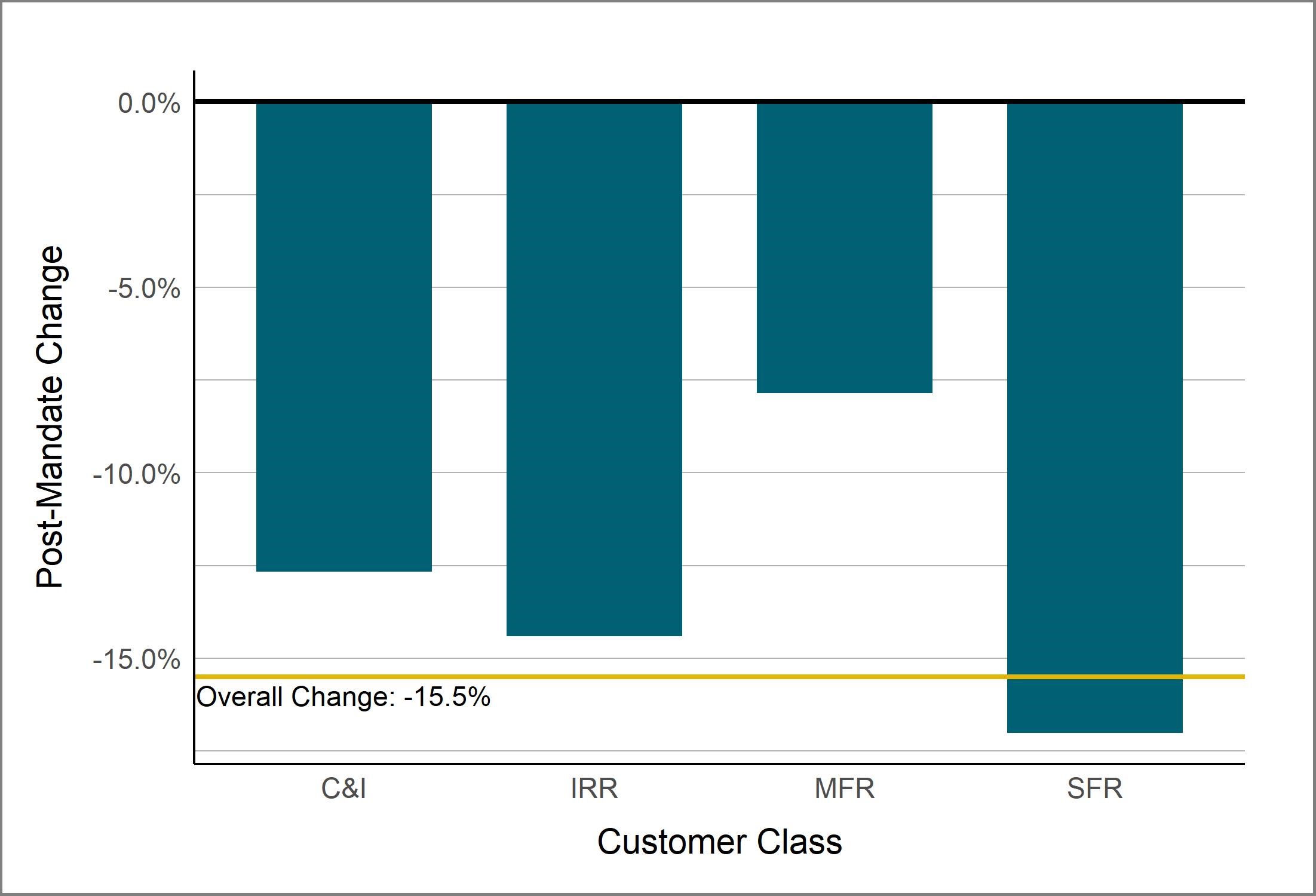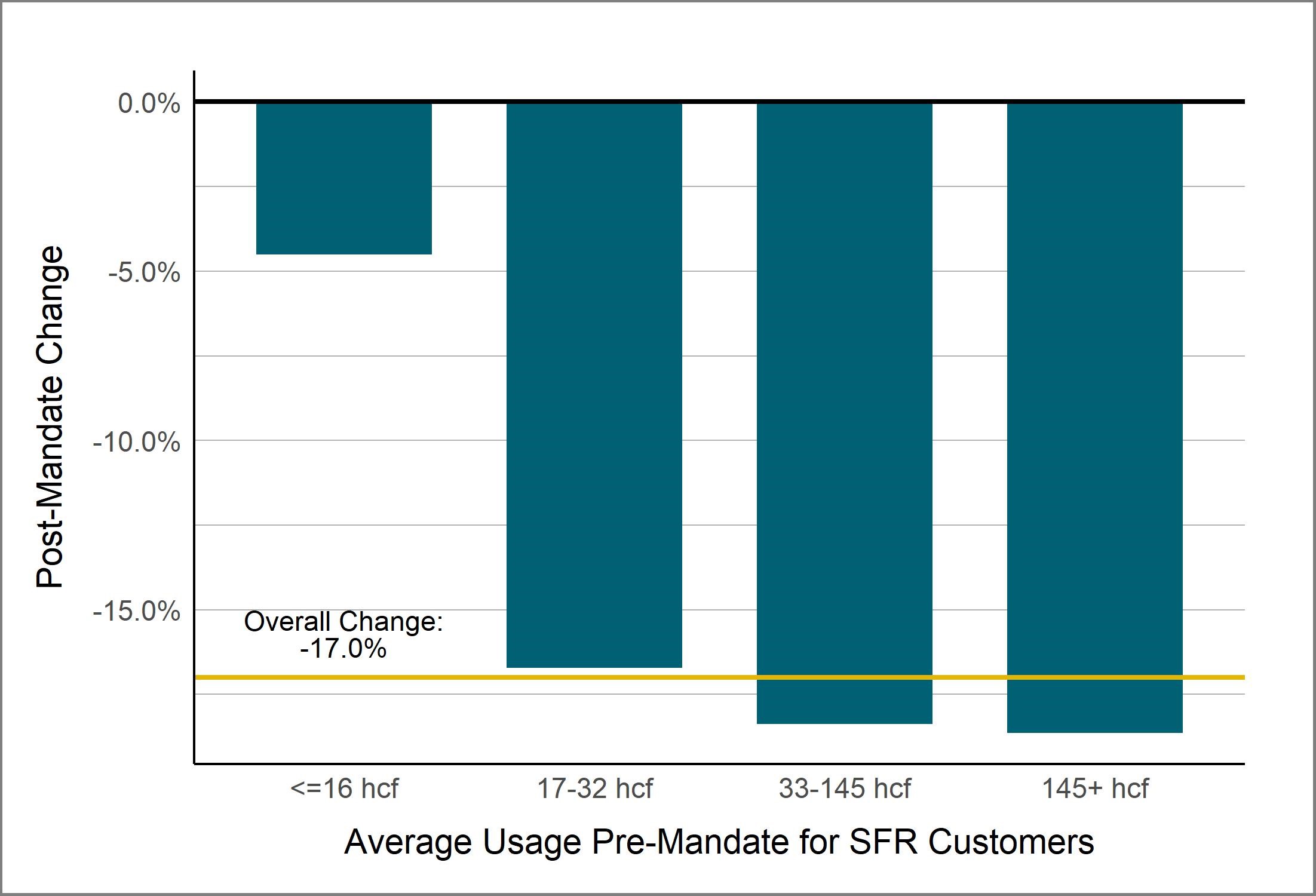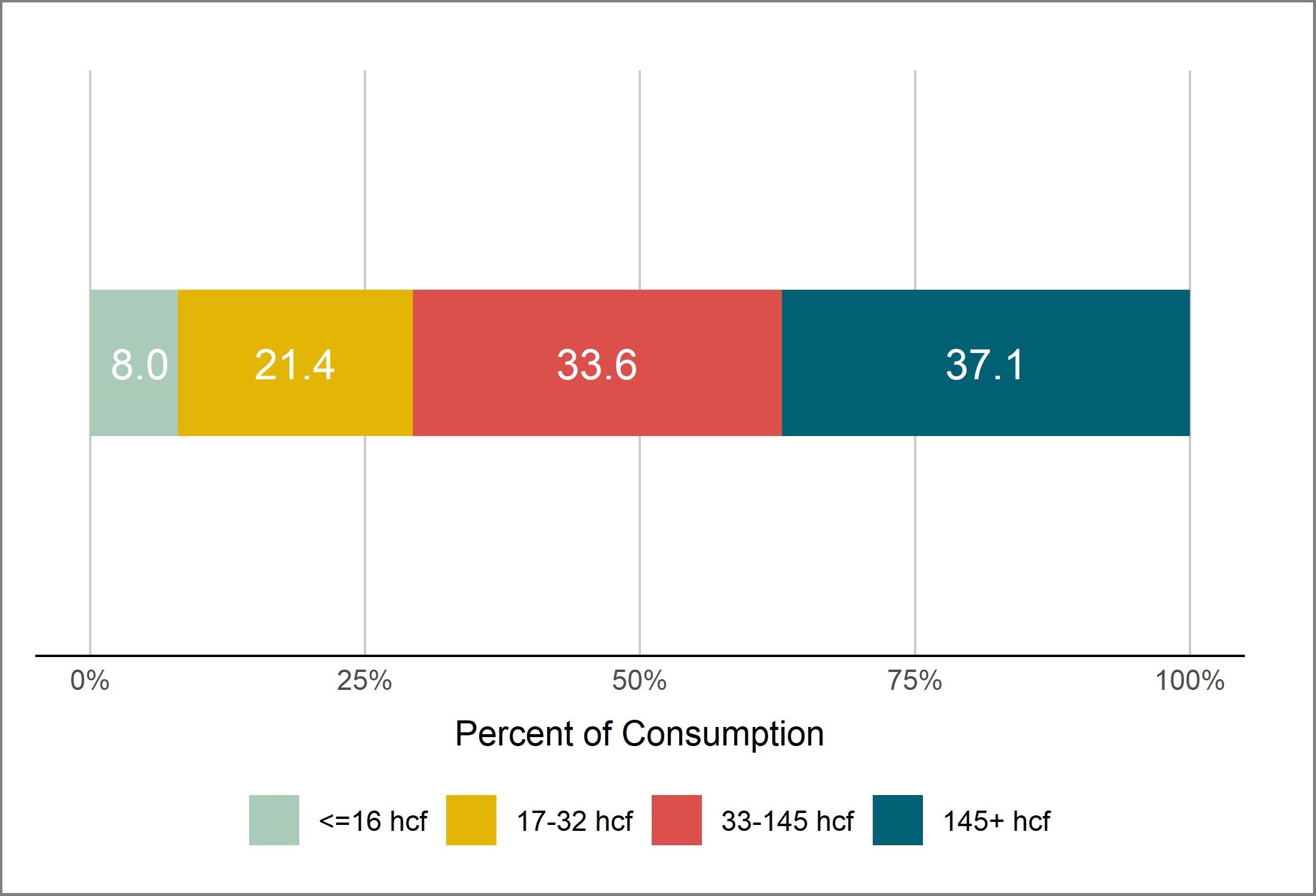Facing another severe drought in California, water agencies across the state are re-thinking how to equitably curb customer usage to meet target reductions. To help, RDN analyzed water consumption from the last state-wide extreme drought (2015) to understand which types of customers are more likely and able to reduce water usage. We have developed five recommendations based on our findings.
Study Overview
In April 2015, then California Governor Jerry Brown directed the State Water Resources Control Board to impose a 25 percent mandatory usage reduction statewide relative to 2013 levels. This came a year after the Governor declared a drought state of emergency. The mandate required each California urban water supply agency to determine how to meet the target reduction and monitor compliance. Water savings totaled over 1.6 million acre-feet for the 12 month-period after the mandate was implemented.
With below-average rainfall and a greatly reduced Sierra snowpack, the State is once again on the brink of severe drought. To help agencies better prepare for future mandatory water reductions, RDN analyzed the effectiveness of water reductions imposed during the 2015 drought across different customer types. For this analysis, RDN utilized a database of historical consumption records from May 2014 to April 2016 for nine agencies across California. We compared year-over-year consumption levels for all customers who reported usage for the duration of the study period. Table 1 displays key summary statistics for the dataset. For the agencies surveyed, total consumption decreased 15.5 percent in the year after the mandate relative to the year leading up to the mandate.
Table 1. Summary Statistics, Drought Impact on Usage for FY 2014 vs. 2016
Usage Reduction by Customer Class
Figure 1 displays the percentage reductions by customer class in the year following the year of the reduction mandate. Single-family residential customers demonstrated the largest reduction in consumption (17.0 percent), followed by irrigation customers (14.4 percent), and Commercial & Industrial customers (12.7 percent). Multi-family residential customers had the smallest reduction (7.8 percent) of all customer classes. As most multi-family residential usage is indoors, the significant difference between single- and multi-family residential customers’ reductions suggests that most of the reduction for single-family residential customers came from reductions in outdoor usage.
Figure 1. Post-Mandate Usage Reduction by Customer Class
Single-Family Residential Customers Usage Patterns
Single-family residential customers comprise the majority of California urban water suppliers’ customer base and water usage. As shown in Figure 1, single-family residential customers contributed the largest percentage reduction in water usage in the year after the drought mandate. Understanding how single-family residential customers respond to mandatory drought restrictions is crucial for agencies heading into dry periods. We further evaluate this customer class by subdividing single-family residential customers into groups based upon their pre-drought consumption levels.
Figure 2 presents the percentage reductions for single-family residential customers based on their pre-drought mandate consumption patterns. We break customers down into four equal groups (quartiles) based on their consumption levels in hundred cubic feet (hcf). The results support a straightforward but important conclusion about the price elasticity of water and the differences between essential and discretionary usage. Most of a water agency’s smallest users likely consume just enough water to cover their essential needs, including water for drinking and cooking, toilets, showers, and washing dishes/clothes. So even when the price of water increases, their consumption does not change much; in this case only -4.5 percent. Larger users are more likely to consume water beyond their essential needs, and therefore can absorb larger reductions by limiting their non-essential, or discretionary, water use. Discretionary usage for residential customers may include watering lawns/plants, washing the car, etc. In our dataset, larger users (over 16 hcf per year) reduced their consumption by between 16.7 and 18.6 percent in the 12 months following the State’s reduction mandate.
Figure 2. Single-Family Residential Post-Mandate Usage Reduction by Consumption Level
Given that smaller users are unable to significantly reduce their consumption, it is ineffective and unfair for agencies to implement drought surcharges expecting all customers to reduce their usage by the same amount or percentage. Instead, agencies should develop reduction targets that depend on the user’s existing usage relative to levels of essential use. An analysis of how usage is distributed is necessary to determine reduction targets. Figure 3 presents the share of total water consumption (pre-mandate) associated with each quartile of consumption levels. The 25 percent of households with the lowest usage (less than or equal to 16 hcf) comprise only 8.0 percent of total usage. In contrast, the 25 percent of households with the highest usage (145+ hcf) account for 37.1 percent of the total water use, and the top 50 percent of highest usage households account for 70.7 percent of total use. Because high-use consumers are responsible for such a large share of total usage, focusing reduction efforts on these users presents the most efficient path to meeting reduction mandates.
Figure 3. Distribution of Usage across SFR Consumption Level Groups

Recommendations
Droughts in California come with pressure on customers to reduce their consumption. For many agencies, this decreased consumption poses a financial risk. Based on this analysis, RDN offers the following recommendations to California water agencies to promote financial stability while still encouraging conservation efforts during the ongoing drought.
- Target single-family residential customers’ outdoor water use – Single-family residential customers’ outdoor water use constitutes the largest discretionary use of urban water. In order to reach conservation goals, agencies should target single-family residential customers’ outdoor water use when planning reductions.
- Target larger reductions for larger users – Because large users comprise such a high percentage of total usage, agencies should target these users specifically when they design their conservation plans. If the State mandates that agencies reduce consumption by a certain percentage, then agencies should analyze their customers’ usage patterns and formulate a plan that incentivizes larger users to reduce their consumption by more than the mandated percentage. Similarly, small users, whose water use mostly reflects essential indoor functions, should not be expected to reduce their consumption by the mandated percentage.
- No drought surcharge for indoor usage – A certain amount of water used by residential customers is essential for health and safety. If a water agency elects to impose a surcharge to recover lost revenue due to drought, we advise that agencies only charge for consumption over a baseline amount that the agency deems essential. (The “essential usage” amount may vary between agencies depending on the climate, community demographics, and characteristics of the housing stock). Furthermore, this analysis demonstrates that a baseline amount of indoor usage is relatively impervious to reduction mandates, which implies that it does not contribute to the loss in revenue that results from reduced consumption.
- Project actual water savings – Drought surcharges applied to the upper tiers of water use (under multi-tiered water rate structures) should be calculated by projecting the actual revenue lost due to customer use reductions. Because customers reduce their discretionary usage first, most of the volumetric revenue losses will come from usage in the highest cost tiers (assuming an increasing block rate structure). As a result, a 20 percent reduction in usage will most likely cause a greater than 20 percent reduction in volumetric revenue.
- Structure rates to reflect indoor, outdoor, and excessive usage: AB 1668 and SB 606 set standards for efficient indoor and outdoor water usage. Water agencies can adjust their rate structures to differentiate between efficient and excessive consumption. Such a rate structure provides a framework that allows agencies to use price signaling to target not only outdoor water use, but also excessive water use. The gold standard for this kind of rate structure is budget-based rates set at the individual- or customer class-level.
If you have any questions about these recommendations or want to conduct this analysis on your own customers to tailor your conservation efforts, please reach out to our Senior Financial Analyst Ms. Ichiko Kido at Ichiko@rdniehaus.com or via phone at 805-962-0611.
